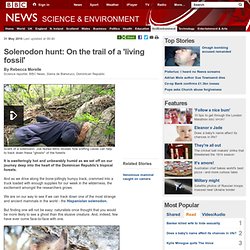

Biobrick. Anfibios. Especies. Ecossistema. Extinction. BBC - Earth News - Spider builds life-sized decoys. There is a species of spider that builds models of itself, which it uses as decoys to distract predators.

The spider may be the first example of an animal building a life-size replica of its own body. So believe the scientists who made the discovery, which is published in the journal Animal Behaviour. The arachnid's behaviour also offers one explanation for why many spiders like to decorate their webs with strange-looking ornaments. Many animals try to divert the attentions of predators by becoming masters of disguise. Some try to avoid being seen altogether by using camouflage to blend in against a background, such as the peppered moth evolving motley wings that blend into tree bark, or stick insects that look like sticks. Others evolve more conspicuous ornaments designed to distract a predator, such as butterflies that grow large eyespots or lizards that quickly move colourful tails, which they detach from their bodies if grabbed. Under attack Life-like decoys The decoys worked, too. Mamifero venenoso - Solenodon hunt: On the trail of a 'living fossil'
31 May 2010Last updated at 00:40 By Rebecca Morelle Science reporter, BBC News, Sierra de Bahoruco, Dominican Republic Scent of a solenodon: Joe Nunez-Mino reveals how sniffing caves can help to track down these "ghosts" of the forests It is swelteringly hot and unbearably humid as we set off on our journey deep into the heart of the Dominican Republic's tropical forests.

And as we drive along the bone-joltingly bumpy track, crammed into a truck loaded with enough supplies for our week in the wilderness, the excitement amongst the researchers grows. We are on our way to see if we can track down one of the most strange and ancient mammals in the world - the Hispaniolan solenodon. But finding one will not be easy: naturalists once thought that you would be more likely to see a ghost than this elusive creature. The solenodon is one of just a handful of venomous mammals Continue reading the main story “Start Quote The problem is that we really don't know anything about these animals ” Biophilia hypothesis. The biophilia hypothesis suggests that there is an instinctive bond between human beings and other living systems.

Edward O. Wilson introduced and popularized the hypothesis in his book, Biophilia (1984).[1] He defines biophilia as "the urge to affiliate with other forms of life".[2] Love of living systems[edit] The term "biophilia" literally means "love of life or living systems. " It was first used by Erich Fromm to describe a psychological orientation of being attracted to all that is alive and vital.[3] Wilson uses the term in the same sense when he suggests that biophilia describes "the connections that human beings subconsciously seek with the rest of life.” To many people, "nature" means plants as in a park or forest, but the weather and animals are also closely involved.
Product of biological evolution[edit] Human preferences toward things in nature, while refined through experience and culture, are hypothetically the product of biological evolution.